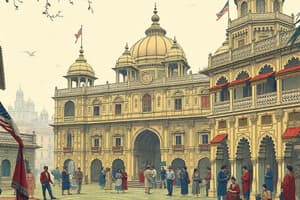Podcast
Questions and Answers
What was the primary goal of the British East India Company's policy of paramountcy in India?
What was the primary goal of the British East India Company's policy of paramountcy in India?
- To establish British dominance in Indian political, economic, and cultural life (correct)
- To facilitate cooperation between Indian princely states and the British government
- To reduce British influence in Indian trade and commerce
- To promote Indian cultural and economic autonomy
What was the result of the British East India Company's expansion in India?
What was the result of the British East India Company's expansion in India?
- The decline of British trade in India
- The establishment of an independent Indian state
- The merger of the Company with Indian princely states
- The transformation of the Company from a commercial venture to an imperial power (correct)
What was the Doctrine of Lapse introduced by the British East India Company in the late 1840s?
What was the Doctrine of Lapse introduced by the British East India Company in the late 1840s?
- A policy of promoting Indian cultural and economic development
- A policy of annexing Indian territories without a natural heir (correct)
- A policy of allowing Indian princely states to adopt European customs
- A policy of non-interference in Indian princely states
When was the British East India Company established?
When was the British East India Company established?
What was the outcome of the First War of Indian Independence in 1857?
What was the outcome of the First War of Indian Independence in 1857?
What was the primary factor that contributed to the growing discontent among the Indian population?
What was the primary factor that contributed to the growing discontent among the Indian population?
What was the significance of the First War of Indian Independence in the history of India?
What was the significance of the First War of Indian Independence in the history of India?
What was the role of the British East India Company in the First War of Indian Independence?
What was the role of the British East India Company in the First War of Indian Independence?
What was the impact of the rumor about the lubricated cartridges on the Indian sepoys?
What was the impact of the rumor about the lubricated cartridges on the Indian sepoys?
What was the outcome of the First War of Indian Independence?
What was the outcome of the First War of Indian Independence?
Flashcards are hidden until you start studying
Study Notes
The First War of Indian Independence: A Closer Look at the British East India Company
The First War of Indian Independence, also known as the Indian Rebellion of 1857 or the Sepoy Mutiny, was a significant event in the history of India. This widespread but unsuccessful rebellion against British rule began in Meerut in 1857 and spread to Delhi, Agra, Kanpur, and Lucknow. The roots of this rebellion can be traced back to the British East India Company (EIC), which held immense power in India at the time.
The East India Company's Role in India
The British East India Company was established in 1600 and was initially granted a monopoly over British trade in India. Over time, it transformed from a commercial venture to an imperial power, fighting wars and ruling over vast territories in South Asia. The EIC's expansion in India was driven by a policy of British paramountcy, which aimed to establish British dominance in Indian political, economic, and cultural life.
Causes of the Rebellion
The rebellion of 1857 was not a spontaneous event but rather an accumulation of factors over time. One of the primary causes was the EIC's increasing use of tactics to usurp control of the Hindu princely states. The Doctrine of Lapse, introduced in the late 1840s, involved the British prohibiting a Hindu ruler without a natural heir from adopting a successor and annexing their land when the ruler died or abdicated.
The Enfield Rifle Incident
The rebellion was sparked by the introduction of the new Enfield rifle, which required the sepoys to bite off the ends of lubricated cartridges to load it. A rumor spread among the sepoys that the grease used to lubricate the cartridges was a mixture of pigs' and cows' lard, which was considered an insult to both Muslims and Hindus.
The Impact of the Rebellion
The rebellion failed to achieve its goals and ended with the British re-establishing their control over India. However, the memories of this rebellion lived on in the minds of Indians living under direct British rule. Some historians argue that it was the beginning of the Indian national independence movement.
Conclusion
The British East India Company played a crucial role in the First War of Indian Independence. Its expansionist policies in India, including the Doctrine of Lapse, contributed to the growing discontent among the Indian population. The introduction of the Enfield rifle and the rumor about its cartridges proved to be the spark that ignited the rebellion. Despite its failure, the rebellion marked a significant moment in the history of India and is remembered as a turning point in the country's struggle for independence.
Studying That Suits You
Use AI to generate personalized quizzes and flashcards to suit your learning preferences.




